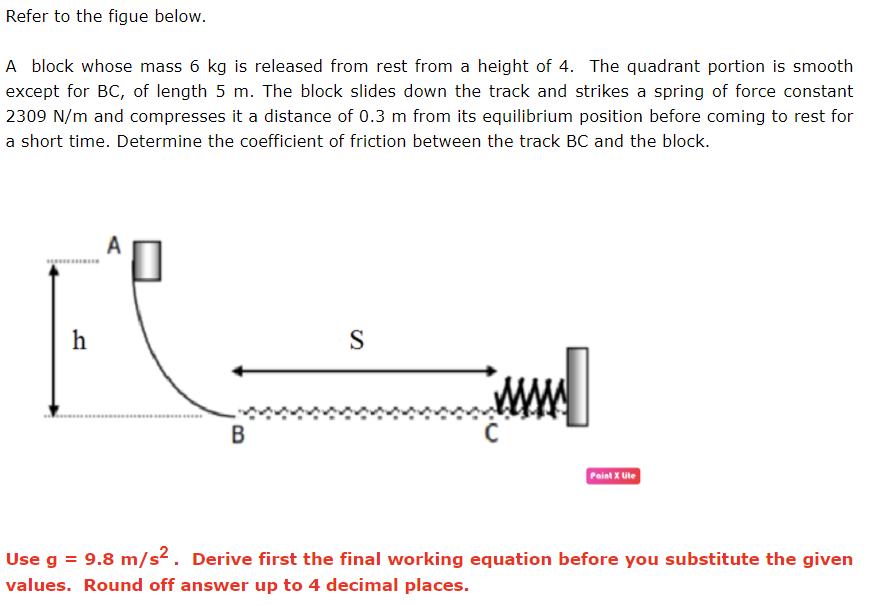A block whose mass 6 kg is released from rest from a height of 4. The quadrant portion is smooth except for BC, of length 5 m. The block slides down the track and strikes a spring of force constant 2309 N/m and compresses it a distance of 0.3 m from its equilibrium position before coming to rest for a short time. Determine the coefficient of friction between the track BC and the block.
A block whose mass 6 kg is released from rest from a height of 4. The quadrant portion is smooth except for BC, of length 5 m. The block slides down the track and strikes a spring of force constant 2309 N/m and compresses it a distance of 0.3 m from its equilibrium position before coming to rest for a short time. Determine the coefficient of friction between the track BC and the block.
Principles of Physics: A Calculus-Based Text
5th Edition
ISBN:9781133104261
Author:Raymond A. Serway, John W. Jewett
Publisher:Raymond A. Serway, John W. Jewett
Chapter7: Conservation Of Energy
Section: Chapter Questions
Problem 15P: A block of mass m = 2.00 kg is attached to a spring of force constant k = 500 N/m as shown in Figure...
Related questions
Question
help asapp

Transcribed Image Text:Refer to the figue below.
A block whose mass 6 kg is released from rest from a height of 4. The quadrant portion is smooth
except for BC, of length 5 m. The block slides down the track and strikes a spring of force constant
2309 N/m and compresses it a distance of 0.3 m from its equilibrium position before coming to rest for
a short time. Determine the coefficient of friction between the track BC and the block.
S
B
Paint X Ute
Use g = 9.8 m/s². Derive first the final working equation before you substitute the given
values. Round off answer up to 4 decimal places.
Expert Solution
This question has been solved!
Explore an expertly crafted, step-by-step solution for a thorough understanding of key concepts.
Step by step
Solved in 2 steps with 2 images

Knowledge Booster
Learn more about
Need a deep-dive on the concept behind this application? Look no further. Learn more about this topic, physics and related others by exploring similar questions and additional content below.Recommended textbooks for you

Principles of Physics: A Calculus-Based Text
Physics
ISBN:
9781133104261
Author:
Raymond A. Serway, John W. Jewett
Publisher:
Cengage Learning

An Introduction to Physical Science
Physics
ISBN:
9781305079137
Author:
James Shipman, Jerry D. Wilson, Charles A. Higgins, Omar Torres
Publisher:
Cengage Learning

College Physics
Physics
ISBN:
9781305952300
Author:
Raymond A. Serway, Chris Vuille
Publisher:
Cengage Learning

Principles of Physics: A Calculus-Based Text
Physics
ISBN:
9781133104261
Author:
Raymond A. Serway, John W. Jewett
Publisher:
Cengage Learning

An Introduction to Physical Science
Physics
ISBN:
9781305079137
Author:
James Shipman, Jerry D. Wilson, Charles A. Higgins, Omar Torres
Publisher:
Cengage Learning

College Physics
Physics
ISBN:
9781305952300
Author:
Raymond A. Serway, Chris Vuille
Publisher:
Cengage Learning

College Physics
Physics
ISBN:
9781285737027
Author:
Raymond A. Serway, Chris Vuille
Publisher:
Cengage Learning

University Physics Volume 1
Physics
ISBN:
9781938168277
Author:
William Moebs, Samuel J. Ling, Jeff Sanny
Publisher:
OpenStax - Rice University

Physics for Scientists and Engineers
Physics
ISBN:
9781337553278
Author:
Raymond A. Serway, John W. Jewett
Publisher:
Cengage Learning